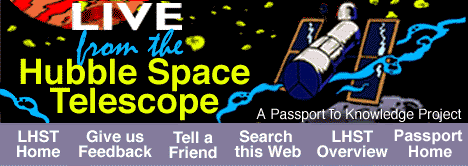
The Hubble team answers your
questions
Browsing answers to questions already asked
A listing of categories containing questions asked and answered
previously is being maintained. This listing of questions and answers is readily
available.
Asking the Hubble team your questions
The opportunity to send Email questions to the men and women of the
Hubble team was available from March through early June 1996; it is no
longer available.
We are grateful to the HST folks for generously volunteering their time
to support this service.
This section will describe some guidelines and procedures that were used for the process.
K-12 students and teachers could Email questions to researchers, engineers
and support staff. This interaction was supported by a "Smart
Filter" who protects the professional from Internet overload by
acting as a buffer. The actual Email addresses of these experts
remained unlisted. Also, repetitive questions were answered from an
accumulating database of replies; thus the valued interaction with
the experts was saved for original questions. (More information
about how you can directly search this database will follow later).
Tips for asking good questions
Each and every expert is excited about connecting with classrooms. But
it is important to remember that the time and energy of these researchers is
extremely valuable. If possible, please review the materials available online
to gain an overall understanding of the basics.It is best
to ask questions that are not easily answered elsewhere. For
example,
"What does the Hubble Space Telescope do?" would not be an appropriate
question.
We recognize that this creates a gray area about whether or not a question
is appropriate. Simply use your best judgment. Since the main idea is to
excite students about the wonders of science and research, please err on
the side of having the students participate.
Some teachers have used a group dynamic to refine the questions that they
email to experts. For example, after first studying HST material, students
divide into groups and create a few questions per group. All of the questions
are then shared, and students are given an opportunity to find answers to
their classmates' questions. Those that remain unanswered are sent to the
HST team.
Ideally, the act of sending questions will further engage the student in
their
learning. It may help to think back to an early stage of development when
the 3 year old learns that repeating the word "why" can get parents to do
most of the work in a conversation. The wise parent will try to get child
involvement by asking "why do you want to know?". The same is true in the
classroom. Teachers might want to help students to learn to ask good
questions. Here are three questions the students might ask themselves as
they submit their questions:
What do I want to know?
Is this information to be found in a resource I could easily
check (such as a school encyclopedia)?
Why do I want to know it? ("What will I do with the information?"
or "How will I use what I learn?")
The last question is the most interesting. Student reflection on why they
want to know something is a very valuable learning experience.
Logistics of sending in questions (address and
format)
Questions were accepted from March through early June 1996. Questions
are no longer being fielded.
We tried to acknowledge and answer all questions as quickly as possible.
Our goal was to provide a basic acknowledgment immediately. In most
cases we were able to provide an answer within one week to ten days.
One question per message
If you or your class had several questions which are unrelated, we asked that
you please send each unrelated question in a separate Email message rather
than as one message with many different questions. While this may be
inconvenient, it was important because it helped us to keep track of the
questions and ensure that no question remain unanswered. Messages that
did not follow this request were unnecessarily delayed as we went through
the extra step of splitting up the messages ourselves.
Twenty question limit
Any individual teacher was limited to submitting a total of twenty (20)
questions during the life of the project. Hopefully this encouraged more
classroom discussion about what students wanted to know and led to
research done before asking questions.





![]()